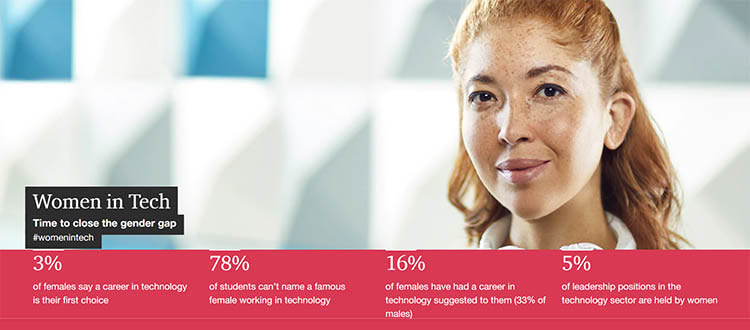Female earnings in the UK need to increase by £93 billion to close the gender pay gap

Despite holding firm in 16th place, the UK is being outpaced by greater improvements in female employment prospects in other OECD countries – despite £189 billion GDP prize if the female employment rate could match Sweden, according to PwC’s latest Women in Work Index, which analyses female economic empowerment across 33 OECD countries.
The top three countries in the Women in Work 2020 Index are Iceland, Sweden and Slovenia, while the UK remains in 16th place.
While the UK performs above the OECD average and is second only to Canada when compared to other G7 economies, its position has barely budged since 2000 when it stood in 17th position, despite improving its performance across all five indicators.
Jing Teow, economist at PwC, commented:
“Although progress has been made across both the UK and OECD, the rate of improvement is still slow, despite the prospect of huge economic gains from increasing female participation in the workforce. Indeed both the OECD and UK would receive massive boosts to GDP amounting to US$6 trillion (£4.63 trillion) and £189 billion respectively if they could match the best performing country, Sweden.
“In order for these gains to be realised, businesses and governments need to work together to help get more women into work and ensure that there is a fair and equal pay structure. It’s also crucial that women get the right opportunities to upskill in the face of increasing automation as we enter the Fourth Industrial Revolution.”
If the female employment rate across the OECD countries matched Sweden, OECD GDP would be boosted by more than US$6 trillion (£4.63 trillion). Closing the gender pay gap across the OECD would increase total female earnings by US$2 trillion (£1.54 trillion). Female earnings in the UK would increase by £93 billion – a rise of 20%.
Overall, the OECD countries achieved incremental gains to female economic empowerment. Iceland and Sweden retain the top two positions for the fifth year in a row, with Slovenia in third place. Czechia experienced the biggest improvement in its ranking of all OECD countries, rising four places from 23rd to 19th, whereas Estonia and Ireland recorded the biggest decline.
The five indicators that make up the Women in Work Index are:
- Gender pay gap
- Female labour force participation
- Gap between male and female labour force participation
- Female unemployment, and
- Female full-time employment rate
UK regional inequalities declining
The South West, Northern Ireland and Wales are the top performing UK regions, with all regions except Scotland improving their absolute score since last year.
Encouragingly, regional inequalities in women’s employment across the UK are declining, with every region except Scotland improving since last year. The East Midlands, North East and West Midlands achieved increases in their index score of more than 12% since last year, mainly driven by broad-based improvements to female labour force participation and full time employment rate. The South West unseated Scotland as the UK’s top region, improving on all indicators, while Northern Ireland jumped from 4th to 2nd.
London performed the poorest on the index due to poor female labour force participation and a high female unemployment rate. It fell three places to 12th, despite being the region that has achieved the most significant improvement in its index score since 2010, indicating that progress has stalled in the capital.
Kay Cooper, Managing Director for RPO for EMEA at recruitment giants Korn Ferry, believes businesses are putting too much emphasis on talent acquisition when attempting to create a more diverse business, and need to focus more on creating an enduring shift in their culture:
“The capital is a leader in most aspects of Britain’s economic life, so it’s surprising and disappointing to see it fall in the UK’s regional ranking for female labour force participation. Part of the problem lies with our approach to diversity and inclusion – while a lot of businesses have initiatives in place, not all are excelling in this area. Given London’s high concentration of businesses, this problem is particularly felt in the capital’s figures.
“A big part of the issue is that too many businesses lean on their recruitment and talent acquisition functions to single-handedly create a more diverse and inclusive organisation. While these functions do, of course, play an important role in attracting a more diverse workforce, efforts should not be limited to this stage.
“D&I requires a long-lasting shift internally to ensure that the talent that talent acquisition identify and attract is properly nurtured once on-boarded within an organisation. After all, if these diverse employees leave after six months because the culture doesn’t actually include them, then all of that effort becomes redundant.”
Women in Tech Time to close the gender gap
Over half of women workers would consider a digital career if they knew how to retrain: #NCW2020 – @IoCoding and @Deloitte Research, released during #InternationalWomensWeek, has unveiled new insights into what motivates women to study and work in… https://t.co/c3hGhNoosq pic.twitter.com/iDfcAswaH8
— FE News – The #FutureofEducation News Channel (@FENews) March 4, 2020
On average across the G7, women account for only 30% of the tech workforce, and even fewer women occupy the top echelons of tech companies, highlighting the need for businesses to improve opportunities for women in the sector.
According to PwC’s Women in Technology Index, which is part of Women in Work, Canada is the best performing country within the G7 in terms of gender representation and equality in the tech sector, with France in second place.
The outlook is less rosy for the UK. In contrast to the main index, on which it is the second best performing country in the G7 and ranks in the top half of the OECD overall (16th), the UK is fifth out of the G7 in the Women in Technology Index. Its poor performance is driven by worse than average performance on all indicators except the share of women on boards in the technology, media and telecoms (TMT) sector.
Kelly Metcalf, Head of Diversity, Inclusion and Wellbeing at Fujitsu UK & Ireland, said:
“Today’s PwC’s latest Women in Work Index is disappointing for the technology sector. Evidence shows that diverse workforces allow organisations to provide collaborative environments where different styles of thinking can come together – allowing for more innovation and better business performance. It’s disappointing that some companies in the tech industry – and generally in London – have yet to realise this.
“There is no quick fix to this. Businesses need to commit to a big vision to achieve gender balance, driving awareness of the opportunities that exist in technology roles today, but also proactively work to ensure a healthy pipeline of talent. For instance they need to encourage more girls to pursue STEM careers by championing the great success stories of existing women in tech, take creative routes to attract diverse talent and ensure diverse talent is properly retained, developed and nurtured with an organisation.
“If we want to continue to see the UK as a ‘digital first’ nation, we must ensure we are investing in all talent. However, only when organisations fully understand the role that gender diverse organisations can play in driving business growth and success will businesses across the UK be consistently motivated to act differently and bring change.”
Laura Hinton, chief people officer at PwC UK, commented:
“Technology is front and centre for businesses and wider society, so it’s vital we take steps to make the industry as inclusive as possible. It’s encouraging to see progress being made in opportunities for women across the UK as businesses invest across the country, but more needs to be done.
“Long-term, targeted solutions will be vital in making changes sustainable. We know that in areas such as STEM women are under-represented. In order to build and sustain a pipeline of diverse talent, businesses need to work together to encourage girls at young ages through initiatives such as Tech She Can – a programme which inspires and educates young women to get into tech careers.”
The study indicates that AI and new technologies, such as robotics, drones and driverless vehicles, could displace jobs for women, but can also create new ones. Fewer female jobs are expected to be lost due to technology relative to jobs lost for the male population in the OECD, but the gains from job creation are likely to be bigger for men than women. The health and social care sector, the largest employer of women in the OECD, is expected to experience a net increase in female employment as a result of technology. However, the wholesale and retail trade and manufacturing sectors in the OECD are expected to experience a net decrease in female employment as a result of technology.
As workers are increasingly impacted by technology – a recent PwC global skills survey found that more than half of workers globally believe that automation will either significantly change or make their job obsolete within the next decade – it is vital that governments and businesses work together to offer more training in digital skills and STEM subjects, and support retraining into other jobs in sectors where the “human touch” is crucial.

|
Women in Work Index rank |
UK region |
|
1 |
South West |
|
2 |
Northern Ireland |
|
3 |
Wales |
|
4 |
Scotland |
|
5 |
South East |
|
6 |
East |
|
7 |
North West |
|
8 |
North East |
|
9 |
East Midlands |
|
10 |
Yorkshire & Humber |
|
11 |
West Midlands |
|
12 |
London |











Responses